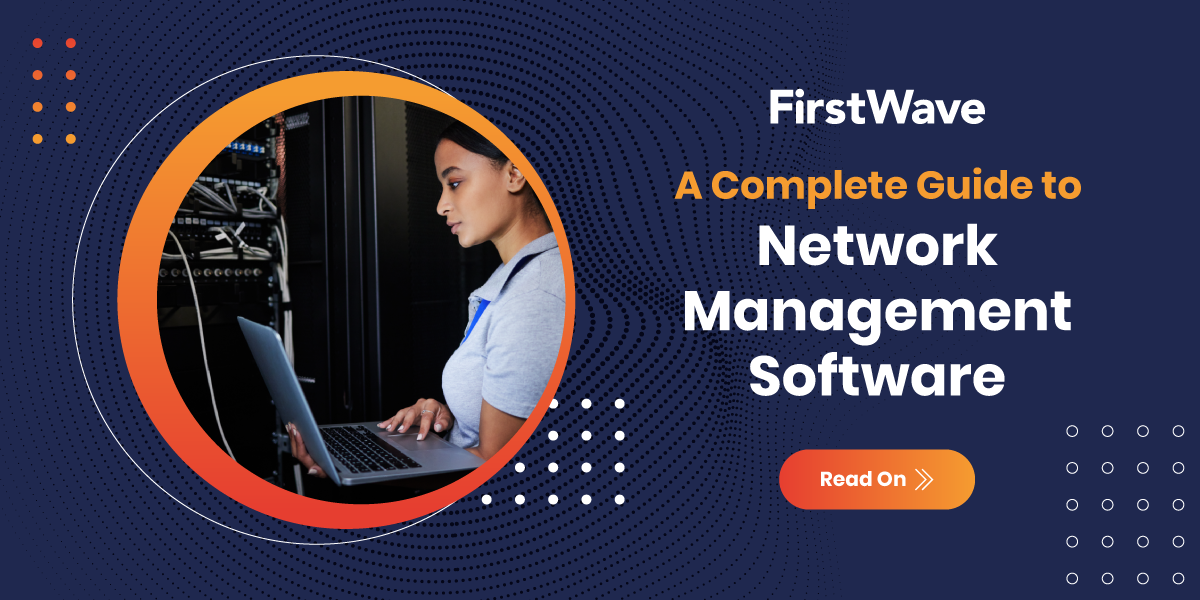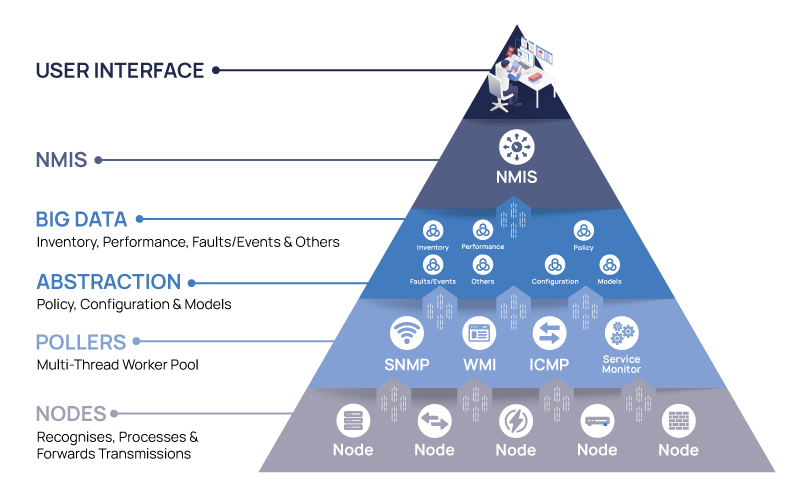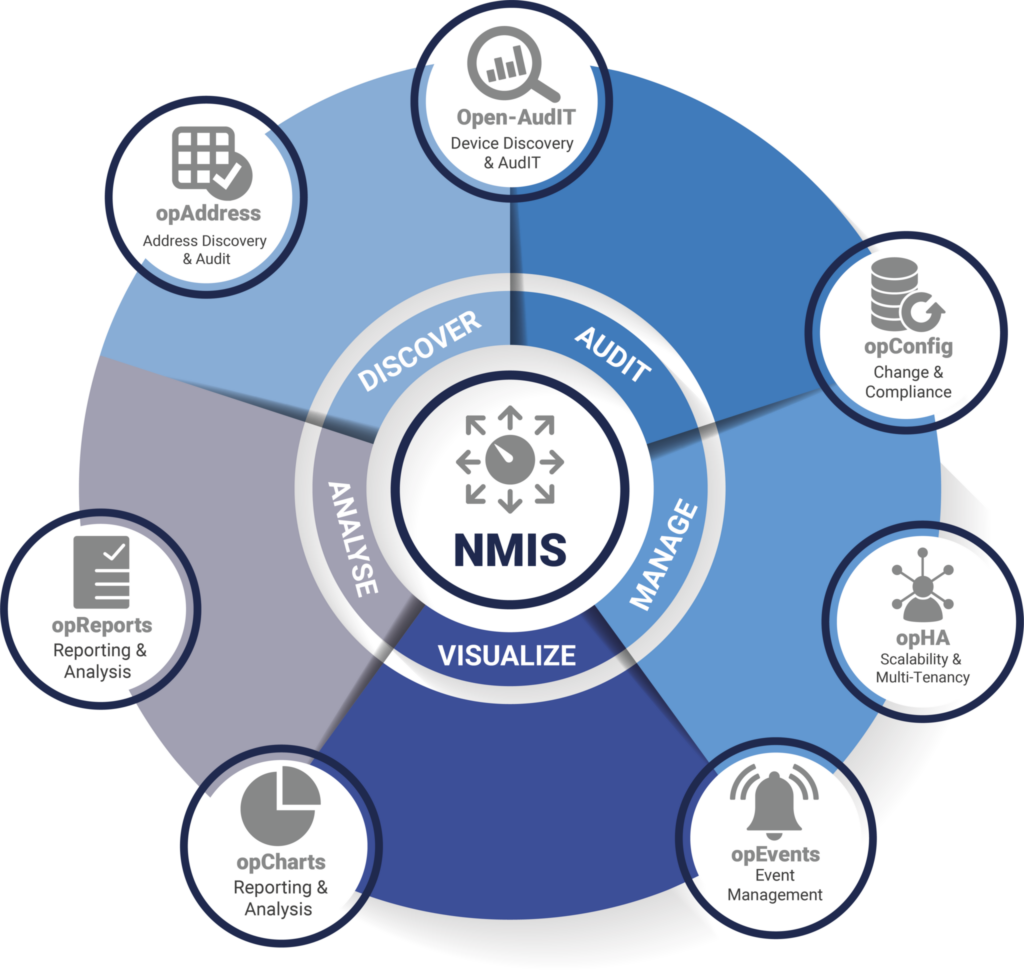30 September 2024
A Complete Guide to Network Management Software

Learn what it does, how it works, how it can benefit you, and how to choose the right software for your business.
Table of contents
- What is network management software?
- How does network management software work?
- Why use network management software?
- Network management software tools
- How to choose a network management software
- Manage your network with NMIS
As organizations scale their operations and virtualize more of their infrastructure, networks are growing more complex. Add in AI integration, network automation, and globalized remote workforces, and this complexity multiplies.
Businesses need the right tools to ensure their network—and their entire operation—continues to run smoothly as they modernize. This is where network management systems come in. According to Grand View Research, the global network management market is expected to grow at a compound annual growth rate (CAGR) of 10.1% from 2023 to 2030.
Whether you’re managing a handful of network devices or enterprise-level infrastructure, the best way to protect your employee productivity and customer experience as you grow is by using network management software (NMS). This guide covers how NMS works, how your business will benefit from using it, and how you can choose the right provider for you.
What is network management software?
In short, NMS gives network teams a bird’s-eye view of every connected device on their network including routers, switches, servers, and even IoT devices. As a result, network administrators can manage configurations, track network usage, troubleshoot devices, and identify minor issues before they escalate.
How does network management software work?
At a high level, NMS integrates with your network to collect, analyze, and present data from every connected device. In order to do this, NMS is made up of network monitoring tools, device configurations, event tracking capabilities, and logging mechanisms that perform the following functions:
- Data collection: NMS uses protocols like Simple Network Management Protocol (SNMP), SNMP traps, Internet Control Message Protocol (ICMP), syslog, or Application Programming Interface (API) to continuously collect real-time data on device status, performance, and network traffic from devices including routers, switches, and servers.
- Network analysis: after collecting data, NMS will analyze it to intelligently detect issues like high latency, downtime, or unusual traffic patterns.
- Alerts and notifications: customizable alerts can be automatically set when performance thresholds are breached, for example, when bandwidth exceeds a set limit. These alerts can be sent to administrators via email, SMS, dashboard notifications, or an IT Service Management (ITSM) platform like ServiceNow or Jira.
- Automation: NMS can automate routine tasks like device configuration updates or failed device resets, based on parameters set by the network administrator.
- Logging and reporting: NMS maintains network activity logs that can be used for troubleshooting, audits, or compliance support. You can also generate detailed reports to help your team analyze trends over time and plan for future capacity needs.
The data collected from these functions is displayed on visual dashboards in the NMS platform, where you can explore and extract detailed network insights.
NMS is usually easy to set up: simply download from your chosen vendor and install on a server (typically Windows Server or Linux) connected to the network/s you want to manage. Then, configure it by following the vendor’s installation instructions to get full visibility of your network.

An example of how NMS works with FirstWave’s Network Management Information System (NMIS).
Why use network management software?
Today’s networks often involve cloud services, hybrid architectures, and remote devices. In this environment, running a network without any kind of management system is like flying a plane with no instrument panel – possible, but incredibly risky and inefficient.
Network management software helps network administrators prevent challenges like:
- Limited visibility which can lead to severe network security breaches, missed opportunities to optimize, or outages that may go unnoticed for hours and impact business operations (for example, the recent CrowdStrike outage)
- Performance issues caused by suboptimal traffic flows, inefficient resource consumption, and easy-to-miss network errors
- Siloed network management that makes it difficult for your IT team to apply updates and automations at scale, leading to performance problems and security vulnerabilities
- Missed opportunities to optimize your network performance, efficiency, and costs
- Manual configuration management, which is time-consuming and prone to human error.
On the other hand, investing in network management software comes with a host of benefits:
- Accurate inventory management: get end-to-end network visibility at a glance and easily manage which devices can access your network.
- Increased efficiency: offload essential network functions like device audits, security checks, and performance management, freeing up your network team to focus on more strategic tasks.
- Better performance: find opportunities to optimize your traffic flow and resource consumption, reducing latency and hops where possible.
- Proactive issue resolution: NMS provides real-time insights, enabling teams to catch and resolve potential outages and issues before they affect end users.
- Improved security: comprehensive monitoring tools track network activity, helping to identify potential security breaches early.
- Cost savings: by automating tasks and reducing downtime, businesses save money on maintenance and avoid the high costs that can come with network failures.
- Enabled automation: automate network changes and software updates to prevent “holes” in your network and save time.
- Right-sized forecasting: use the detailed data available to accurately predict and prepare for future capacity needs, so you don’t overspend or underprovision.
Improve your network management with our guide to network discovery, auditing, and compliance.
Network management software tools
A good NMS suite will offer several tools to give you full control over your network management experience. These are the various tools and features typically offered:
Monitoring
Network monitoring is the foundation of NMS. It provides real-time visibility into your network performance and helps track devices, traffic, and potential threats.
- Proactive monitoring: identifies issues like latency or bandwidth overload before they impact user experience.
- Device status checks: continuously monitors connected devices for availability and performance.
- Performance tracking: collects several metrics to help you manage your network performance including latency, packet loss, congestion, server load, and storage utilization, just to name a few.
Configuration management
Configuration management helps IT teams control settings and updates across every network device.
- Automated backups: regularly backs up configuration files to avoid data loss.
- Configuration rollbacks: easily restores the last known good configuration if an error occurs.
- Streamlined updates: automatically pushes updates to all devices, minimizing downtime and ensuring consistency.
Alerts and events
Network alerts are crucial to minimizing downtime and catching issues before they impact your bottom line.
- Customizable alerts: notifies chosen users based on custom-set thresholds for metrics – for example, traffic spikes, device failures, or underlying application performance spikes.
- Proactive notifications: provides the ability for teams to proactively respond to network events in real time, before they become critical issues.
- Escalation policies: tiered alert systems notify different teams based on the severity of the issue, ensuring relevant people are made aware in real time. These systems can also perform other functions like running system checks to ensure availability of required troubleshooting output for quick remediation, creating tickets to external ITSM platforms, etc.
Tracking and traffic insights
Understanding how your network traffic moves can empower you to make noticeable performance improvements.
- Analyze traffic flow: pinpoints bandwidth hogs and routing inefficiencies that may be impacting overall network performance.
- Identify usage patterns: shows which applications or devices are consuming the most resources, empowering you to make improvements.
- Optimize bandwidth allocation: prioritizes business-critical applications over other applications to accelerate your time to revenue.
Logging and auditing
Network logs and audits provide a detailed record of all network activity, and are an invaluable tool for troubleshooting and security audits.
- Detailed logs: records every network event, from login attempts to configuration changes, giving you full visibility.
- Compliance audits: maintains accurate and detailed records that can help meet regulatory standards.
- Troubleshooting: uses logs to identify patterns or errors that may be causing network issues or to identify general areas of improvement.
How to choose a network management software
There are several NMS options currently on the market, but not all are equal. To make sure you get the best possible value out of your NMS, look for a provider with:
- Out-of-the-box functionality for quick and easy setup;
- A simple and scalable business rules engine so you can easily integrate and scale it with your network as your business grows
- A large number of supported vendors so you can easily integrate it with your existing network and scale up over time
- Detailed visual dashboards that feature several ways for you to explore and view your network monitoring data
- Automated health baselining that compares your device health to the previous baseline period for deep monitoring of your network health
- Customizable alerts and escalations you can adjust to suit your organizational structure, hours of operation, and chain of command
- Support resources to help you get more out of the software – bonus points if they have a community wiki.
With the right provider, NMS will give you a high-speed, efficient, and automated network that can boost your profitability.
Manage your network with NMIS
FirstWave Network Management Information System (NMIS) is a complete NMS that handles the collection, rules, and presentation of your network data, from a single office implementation to the largest distributed environments as well as carrier networks, large global data center deployments, locked down networks, and more.
NMIS uses a single poll (usually SNMP) for performance and fault data, which reduces the bandwidth of network management traffic. The returning data creates real-time performance monitoring and graphing.
When NMIS pollers are deployed throughout your network, they can be easily managed to avoid bottlenecks and enable zero-cost redundancy. Both the front- and back-ends of NMIS are highly extensible, making it easy to add features.

Key features
- Start monitoring your network in a day with a pre-configured, out-of-the-box solution.
- Our powerful, simple business rules engine is easy to scale across networks with any number of devices.
- NMIS supports 10,000 vendors (and continuously growing) for complete integration with your current and future network setup.
- Customize alert escalations to suit your business and escalate events based on your organizational structure, hours of operation, or chain of command.
- Generate custom statistics for an extensive list of metrics with personalized reporting.
- NMIS runs on a powerful open-source foundation, allowing you to customize and extend the platform to fit your unique requirements.
Additional modules are also available from FirstWave to extend the capabilities of NMIS:
- opEvents: centralize and automate log and event management.
- opConfig: automate configuration and compliance management.
- opHA: manage distributed networks through a single pane of glass.
- opAddress: audit and manage IP addresses.
- opReports: get advanced analysis and reporting for even deeper insights.
- opCharts: access interactive dashboards and charts.
- opFlow: see exactly what’s happening across your network with advanced traffic analysis.